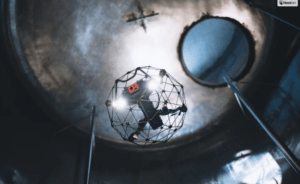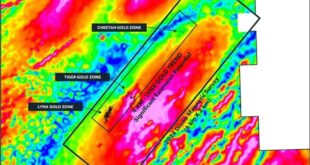Source: Flyability
In 2019, Switzerland-based Flyability had a mystery to solve at the Chernobyl Nuclear Power Plant. Was nuclear waste still present in one of the plant’s decommissioned reactors?
“At the time of the disaster, the fifth block of the Chernobyl Plant was under construction and nearing completion,” a Flyability spokesperson said. “Given the rush to leave, there was no record of whether the holding pools in Reactor Five had ever received the depleted uranium fuel bars for which they had been made.”
Fast forward 33 years – Chernobyl’s decommissioning team needed to know whether any nuclear waste remained in the reactor. Like a flying Sherlock Holmes, Flyability drones took the case.
A First for Drone Inspection
Flyability makes a drone platform for mostly indoor use, flying missions too difficult or dangerous for people. Dashing into the heart of one of the world’s greatest nuclear disasters certainly qualifies as both.
The Elios 2 is commonly used for inspections at nuclear power plants. Company officials say the missions improve safety and significantly reduce the amount of time the plant is shut down for inspection and maintenance. However, this was the first time a Flyability drone flew a mission as part of a plant decommissioning.
A Stressful Drone Flight
“The Chernobyl mission was stressful, because the wall we had to fly over was more than 230 feet high, so there was no way we could get the drone back if the signal was lost,” says Charles Rey, the Training Manager at Flyability and one of the mission’s leaders. “But the mission was a great success, and the people in charge at Chernobyl were very happy with the video and images we were able to collect inside Reactor Five.”
The Chernobyl decommissioning team had little experience with using drones to collect visual data remotely. The Elios 2 presented a unique tool for the work, since it sits inside a protective cage, allowing it to enter confined indoor spaces in order to collect visual data for inspection purposes.
“Although the reactor is structurally sound, access to the areas within it where nuclear waste might have been stored was impossible because the entries were too high off the ground,” Rey said, adding that the drone pilots had to stand in the middle of the reactor in an 82-foot deep pit.
Mystery Solved
The verdict? Visual data from the Elios 2 drone determined the pools were empty — no nuclear waste.
“These findings were significant,” a Flyability spokesperson said. “No evidence that the holding pools were empty had ever been gathered before. Following the mission, the Chernobyl decommissioning team planned to include the visual evidence collected by the Elios 2 in a report submitted to international authorities regarding the status of the plant’s reactors.”
Jason is a longstanding contributor to DroneLife with an avid interest in all things tech. He focuses on anti-drone technologies and the public safety sector; police, fire, and search and rescue.
Beginning his career as a journalist in 1996, Jason has since written and edited thousands of engaging news articles, blog posts, press releases and online content.
Email Jason
TWITTER:@JasonPReagan
Subscribe to DroneLife here.
https://dronelife.com/2020/11/18/drones-solve-a-nuclear-waste-mystery-at-chernobyl/
 Unmanned Aerial Vehicle The latest drone news
Unmanned Aerial Vehicle The latest drone news




